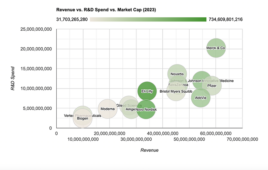 Lilly’s tirzepatide notched an FDA approval for chronic weight management, potentially clearly the way for billions in additional sales. Analysts have projected that the drug could fetch $26 billion in annual sales by 2030, with roughly two-thirds of that sum related to obesity treatment. Bank of America analyst Geoff Meacham is even more optimistic, predicting that sales could hit $48 billion annually.
Lilly’s tirzepatide notched an FDA approval for chronic weight management, potentially clearly the way for billions in additional sales. Analysts have projected that the drug could fetch $26 billion in annual sales by 2030, with roughly two-thirds of that sum related to obesity treatment. Bank of America analyst Geoff Meacham is even more optimistic, predicting that sales could hit $48 billion annually.
The company is calling the obesity-branded version of the drug Zepbound, in contrast to Mounjaro, which won FDA approval for type 2 diabetes on May 13, 2022.
Lily’s stock was up 3.20% to $619.13. Year-to-date, its share price is up almost 70%, in part as a result of strong sales prospects for tirzepatide.
The table below outlines the starting cash prices for a range of GLP-1 receptor agonists. Lilly’s Zepbound, the obesity-branded version of tirzepatide, has a competitive starting price in the segment. With insurance, Zepbound could cost as low as $25 for eligible patients under a special savings program, while Wegovy could cost as little as $25 with insurance coverage and potentially more depending on individual insurance plan details.
Tirzepatide weight management FDA approval could drive further sales growth
| Medication | Cash price starting at (USD) |
|---|---|
| Wegovy | $1,302 |
| Zepbound | $1,059.87 |
| Ozempic | $906 |
| Trulicity | $901 |
| Rybelsus | $906 |
| Saxenda | $1,302 |
| Victoza | $1,079 |
| Bydureon Bcise | $778 |
In recent quarters, tirzepatide as Mounjaro (for managing type 2 diabetes) have achieved quarter-over-quarter sales growth ranging from about 44% to 72%. The product won FDA approval for type 2 diabetes in May 2022.
Similarly, semaglutide sales growth has been astronomical in recent quarters. Year-over-year increases have been as high as 225% in Q1, 536.6% in Q2, and 733.9% in Q3 of 2023.
While head-to-head data are scant, tirzepatide may offer superior weight-loss support to semaglutide. While semaglutide is a glucagon-like peptide-1 (GLP-1) receptor agonist, tirzaptide targets both GLP-1 and the glucose-dependent insulinotropic polypeptide (GIP) receptor.
Strong weight loss support in studies
In a clinical trial, adults receiving the highest dose of Zepbound lost on average 48 pounds at the highest dose.
Overall, tirzepatide appears to support a greater mean percentage reduction in body weight that is higher than that of semaglutide in clinical trials, although more data would be needed to verify that conclusion. In indirect comparisons using data from the SURMOUNT-1 and STEP 1 trials, tirzepatide achieved a mean difference in weight loss of up to –5.92% compared to semaglutide, with high statistical significance (P < .001). In addition, the odds ratios for achieving a weight reduction of 5% or greater were superior with tirzepatide, at 2.61 for the 10 mg dose and 2.75 for the 15 mg dose.
FDA approved the drug based on data from the phase 3 SURMOUNT-1 and SURMOUNT-2 trials.
According to the FDA, roughly 70% of American adults have either obesity or overweight. The FDA had granted the therapy Priority Review and Fast Track designations given the urgent medical need for novel weight management therapies.
To date, Lilly has struggled to manufacture sufficient quantities to meet demand.
Headwinds for growth of GLP-1 drugs include conservative insurers and the relatively high cost of the therapies.
Lilly will launch a savings card program for those with commercial insurance.
Filed Under: Metabolic disease/endicrinology



